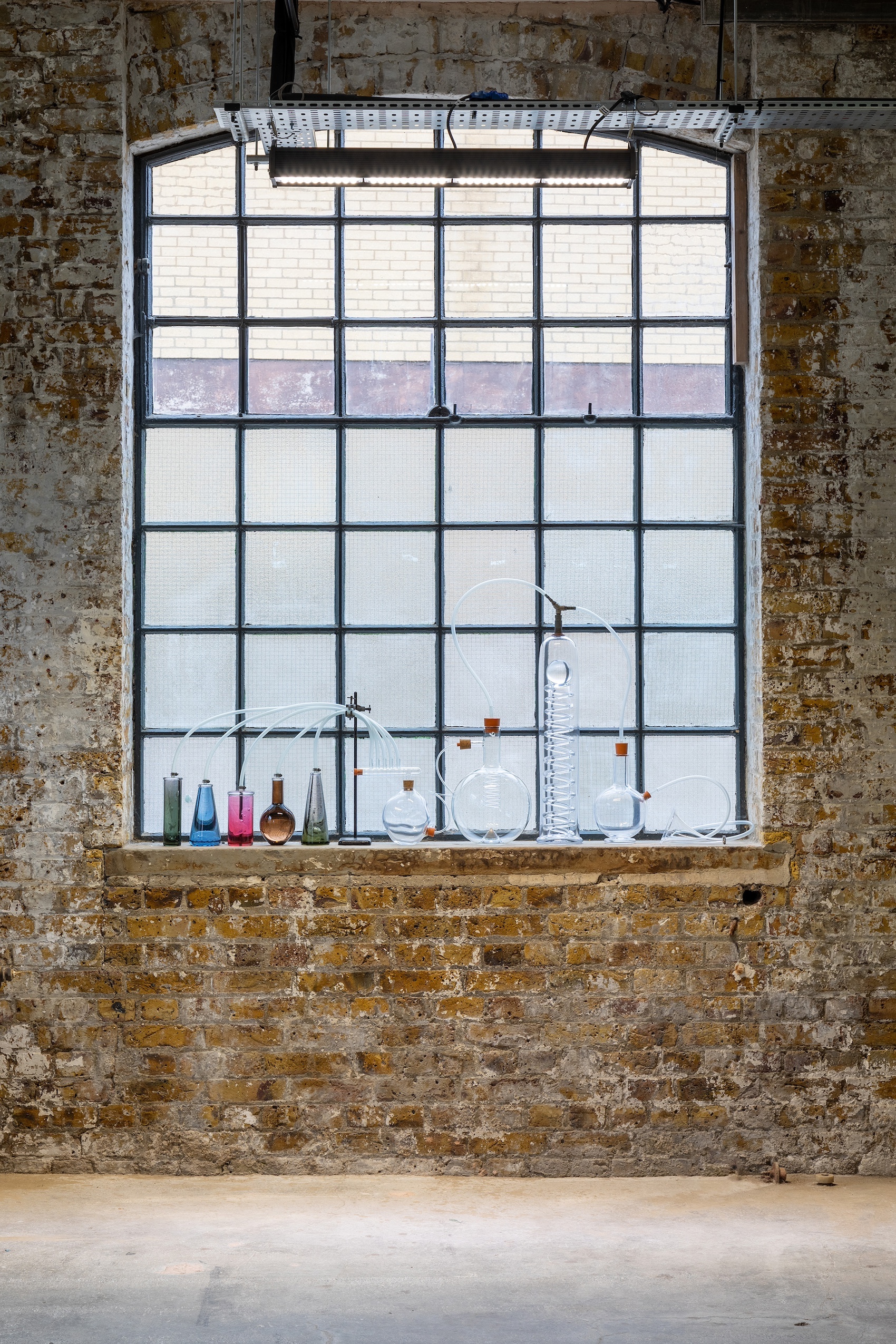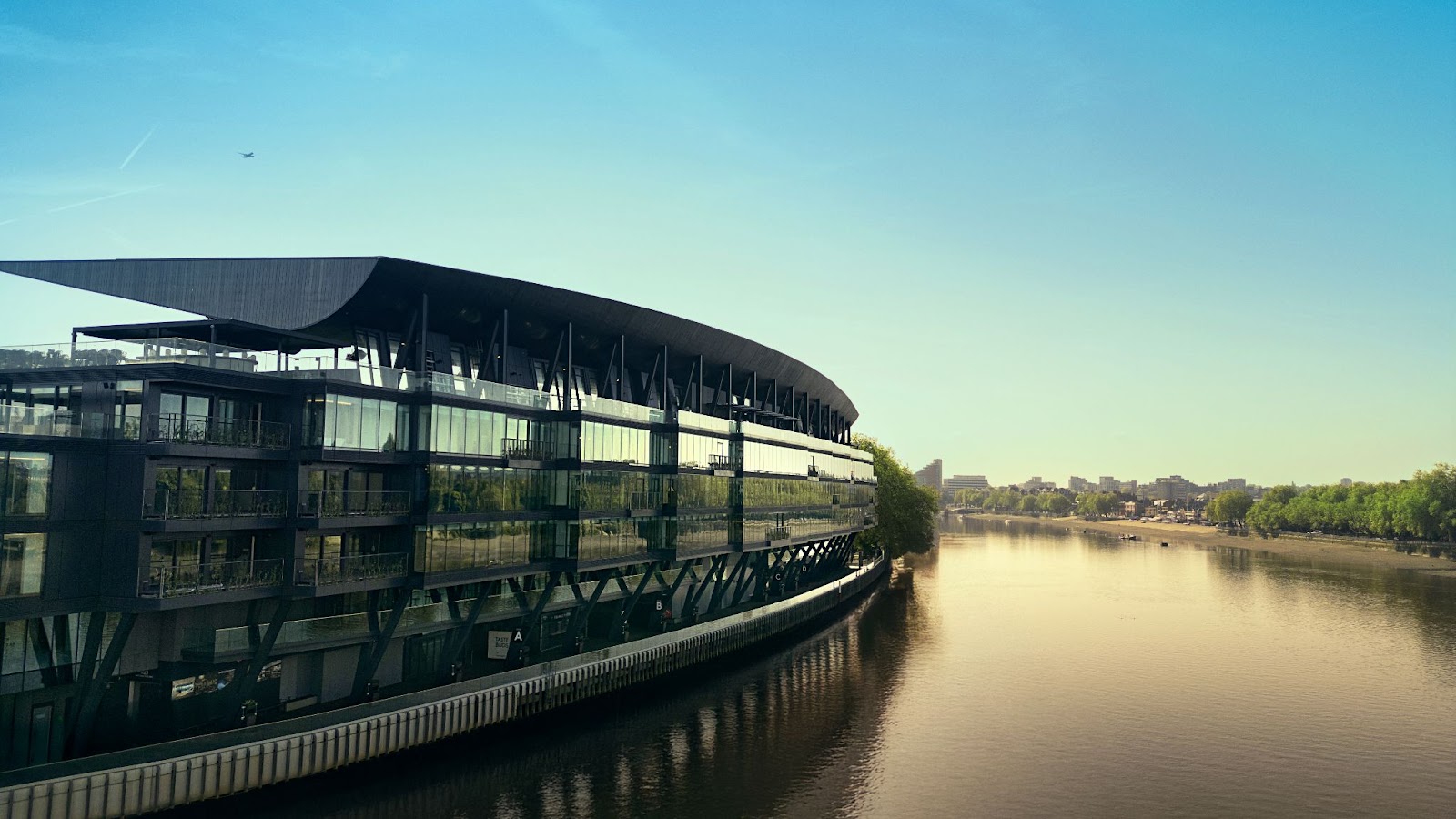Henry Hussey and Sophia Olver, co-founders of OHSH Projects – a travelling artistic project that links artists and spaces – speak to AT about their latest exhibition, VESSEL, currently on show at The Bottle Factory in southeast London.
Sophia Olver and Henry Hussey at the opening of VESSEL at The Bottle Factory on 16th August. Photo by Jon Baker.
VESSEL will be on show for the Regenerative Architecture Index (RAI) launch party on Thursday 12th September, where they will be able to provide insights into the exhibition. Get your tickets to the RAI party here!
What made you launch OHSH Projects and what do you want it to achieve?
We had the idea to set up OHSH Projects during the lockdown, in the early days of 2021. We had been working in the arts throughout our career, and the lockdown had given us a chance to consider what we could do together in the art world. Henry was able to travel into London to go to a printmaking studio and he noticed how many empty shop fronts there were in Soho and the surrounding area in the wake of covid. We realised that we had an opportunity to create exhibitions in these spaces and wanted to combine our skills, work together and create opportunities for the artists we knew, who mostly had a terrible time during the lockdowns. The first space that we were incredibly lucky to inhabit was a unit on New Oxford Street which had been empty for years even before the pandemic. That space gave us the opportunity to meet new artists, experiment and develop what we wanted OHSH Projects to be.
What’s VESSEL about?
VESSEL was curated in response to The Bottle Factory, but it’s also an exhibition we have wanted to curate for a long time. We have a great love of ceramic and glass and have always wanted to curate an exhibition that presents glass and ceramic artists in the same conversation as fine art. The artists in this exhibition explore and expand upon a vessels symbolic capacity to hold, preserve, and convey human experience — whether through the representation of societal structures, emotional states, or the fragility of existence. Through diverse mediums and perspectives, they reveal how vessels transcend their material forms, embodying the complex interplay of history, memory, and identity.
Could you explain how the history of The Bottle Factory has influenced VESSEL?
The history of The Bottle Factory has inspired the conceptual framework for VESSEL by serving as a foundational metaphor for the exhibition’s exploration of vessels as both literal containers and symbolic objects. The history of production, containment, and distribution is mirrored in the artworks, which explore the vessel in its many forms — as a functional object, a cultural symbol, and a metaphor for the human condition. Artist James Devereux’s use of recycled glass from repurposed bottles not only ties into the building’s former use but also speaks to themes of preservation and the continuous cycle of reuse and reinvention. We have allowed the history of the space to shape and inform the curation of the exhibition, creating a dialogue between the past and present.
Many of the artists in VESSEL explore the concept of vessels through different mediums. How does the architectural space of The Bottle Factory enhance or transform the experience of these works, particularly those with site-specific elements?
This is achieved by creating a meaningful dialogue between the artworks and the buildings historical context. The setting is not just a remarkable backdrop, but reinforces the themes explored by the artists, such as containment, memory, and transformation, and this physical connection to the history of vessels enhances the works that deal with similar themes. Artist Camilla Bliss’s installation, which echoes a production line and speaks to the building’s historical role, also considers how we build a relationship between the world we know and ruptured states between consciousness or the unfamiliar.
We chose to place the artworks in a way which embraces the architecture of the building, instead of using plinths to present the glass artworks we placed them on the large Victorian windowsills which has the added benefit of back lighting the artworks. As Fabrix is preserving the space, we were limited by the ways in which we could hang works and could only use pre-existing holes in the walls. This could have been a hinderance, but it instead meant that we were able to innovate — for example, installing Elliot Walker’s artworks surrounding one of the columns.
Alexander Aitken’s installation envelops the entrance to the exhibition. How do his ceramic vessels interact with the architecture of the building, and what do you hope visitors take away from this initial encounter?
The placement of Alexander Aitken’s ceramic sculpture at the entrance of the exhibition highlights the theme of containment and what it means to hold or carry something, both physically and metaphorically. Aitken is concerned with the lost or unnoticed narratives we encounter in our environment and society. His work illustrates how the vessel has come to be used as a metaphor to describe society, and how the diversity of vessels throughout history — from simple clay pots to ornate golden chalices — reflects diversity within societies. From this initial encounter, we hope visitors take away a sense of curiosity and openness to exploring the layered meanings of vessels throughout the exhibition.
As curators, how do you envision the RAI launch party interacting with VESSEL? What synergies do you anticipate between the art on display and the architectural discussions that will take place next month?
Both VESSEL and the RAI share a focus on sustainability, history, and transformation, making The Bottle Factory an ideal venue for these overlapping discussions. The concept of vessels, explored through the artworks, aligns with the regenerative architecture ideals of repurposing, preserving, and enhancing existing structures and environments. The building, once a hub of production and now a space for artistic and cultural dialogue, embodies regenerative principles by adapting its past form and function into something new and valuable. This transformation from a factory into an art space mirrors the regenerative architectural approach of reviving old structures rather than discarding them, preserving history while serving contemporary needs.
More information on the Regenerative Architecture Index launch party can be found here.



























